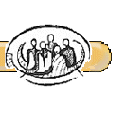|
Browser or web browser: An application that allows a user to access information on the World Wide Web.
Byte: The memory space required for storage of one character- eight bits.
- kilobyte (KB): 1,024 bytes of data
- megabyte (MB): 1,048,576 bytes
- gigabyte (GB): 1,000 megabytes
- terabyte (TB): 1,024 gigabytes
CD-ROM (Compact Disc-Read Only Memory): A device that uses a rigid disc to store information in a form that can be read by a computer.
Clip art: Digitized pictures that can be copied and used in other documents.
Copyright: The legal right granted to a copyright owner to exclude others from copying, preparing derivative works, distributing, performing, or displaying original works of authorship of the owner. Copyrighted works on the Internet are protected under national and international laws. Examples of copyrighted works include literature, music, drama, pictures, graphics, sculpture, and audiovisual presentations.
Cyberspace: Word that was coined by William Gibson in his 1984 sci-fi novel, Neuromancer. Refers to all the sites that you can access electronically. If your computer is hooked up to the Internet or a similar network, then it exists in cyberspace.
Database: A collection of data that is structured and organized into a chosen format. A computer database makes it easy to create, retrieve, and sort data stored electronically.
Digital Camera: A camera that digitizes images and stores them on a computer disk.
Digitize: A process in which information is converted into a format that allows it to be stored and retrieved by a computer.
Dedicated line: A telephone line that is leased from the telephone company and used for one purpose. In cyberspace, dedicated lines connect desktop systems to servers.
|
Dial-in connection: A way to access a computer on the Internet using a PC, telephone line, and modem. Slower than connecting directly to the Internet backbone, but provides accessibility from many sites but does not require specialized equipment.
Domain: The system of organizing the Internet according to country or type of organization, such as educational or commercial. For example, an educational institution would have ".edu" as a suffix to its domain name. Other typical suffixes include ".com" for commercial organizations and ".org" for non-profit groups.
Download: Retrieve information form one computer and save it on another.
E-mail (electronic mail): Messages typed into computer terminals or communications networks and sent electronically to other computer users.
File folder: An organizational structure that allows files to be stored.
Frames: A way to split up Web pages. Frames divide your browser display area into two or more sections (frames). The contents of each frame are taken from different Web pages (each with a different URL). This allows each frame to act independently. In effect, you are interacting with two or more Web pages at once.
Freenet: A community computer network, often based on a local library, that provides Internet access to citizens from the library or sometimes from their home computers.
FTP: File Transfer Protocol is a program that lets you transfer data from an Internet server to your computer.
Hits: A measure of Web site traffic. One hit is counted each time a site visitor views a page or submits a form. Also, one hit is counted for each image (usually graphics) on the page being viewed. While not an exact measurement, hits can be used to make fairly accurate estimates of traffic to any site.
Home page: Document displayed when first accessing a Web site.
Host: A server computer linked directly to the Internet that individual users can access.
|







